Measuring Device Detecting Impact Forces on Impact Rollers
Abstract
1. Introduction
2. Materials and Methods
2.1. Laboratory Device Detecting the Forces of Grains Impacting the Impact Roller
2.2. Laboratory Device for Detecting the Vibration of a Rotating Impact Roller
2.3. Impact Rollers
3. Results
3.1. Measurement of the Force in the Supports of a Conveyor Idler for a Weight Falling on the Casing of an Impact Roller: Placement of the Roller Axle in the Plastic Brackets
3.2. Measurement of the Force in the Supports of a Fixed Conveyor Idler of a Weight Falling on the Conveyor Roller Casing: Placement of the Roller Axle in the Steel Trestles
3.3. Vibration Measurement of the Rotating Rubberized Impact Roller Casing and Steel Roller Axle Bracket
3.4. Vibration Measurement of the Rotating Rubberized Impact Roller Casing, Plastic Roller Axle Bracket
4. Discussion
5. Conclusions
Author Contributions
Funding
Data Availability Statement
Conflicts of Interest
References
- Rozbroj, J.; Necas, J.; Gelnar, D.; Hlosta, J.; Zegzulka, J. Validation of movement over a belt conveyor drum. Adv. Sci. Technol. Res. J. 2017, 11, 118–124. [Google Scholar] [CrossRef] [PubMed]
- Fedorko, G.; Molnar, V.; Grincova, A.; Dovica, M.; Toth, T.; Husakova, N.; Kelemen, M. Failure analysis of irreversible changes in the construction of rubber–textile conveyor belt damaged by sharp-edge material impact. Eng. Fail. Anal. 2014, 39, 135–148. [Google Scholar] [CrossRef]
- Andrejiova, M.; Grincova, A. Klasifikace poškození nárazem na pryžotextilním dopravním pásu metodou Naïve-Bayes. Wear 2018, 414, 59–67. [Google Scholar] [CrossRef]
- Fedorko, G.; Molnar, V.; Zivcak, J.; Dovica, M.; Husakova, N. Analýza poruch textilního pryžového dopravního pásu poškozeného dynamickým opotřebením. Analýza Selhání Tech. 2013, 28, 103–114. [Google Scholar]
- Andrejiova, M.; Grincova, A.; Marasova, D. Identification with machine learning techniques of a classification model for the degree of damage to rubber-textile conveyor belts with the aim to achieve sustainability. Eng. Fail. Anal. 2021, 127, 105564. [Google Scholar] [CrossRef]
- Alviari, L.P.; Anggamawarti, M.F.; Sanjiwani, Y.; Risonarta, V.Y. Classification of impact damage on a rubber-textile conveyor belt: A review. Int. J. Mech. Eng. Technol. Appl. 2020, 1, 21–27. [Google Scholar] [CrossRef]
- Bortnowski, P.; Kawalec, W.; Krol, R.; Ozdoba, M. Types and causes of damage to the conveyor belt–Review, classification and mutual relations. Eng. Fail. Anal. 2022, 140, 106520. [Google Scholar] [CrossRef]
- Hicke, K.; Hussels, M.T.; Eisermann, R.; Chruscicki, S.; Krebber, K. Distributed Fibre Optic Acoustic and Vibration Sensors for Industrial Monitoring Applications. In Proceedings of the AMA Conferences 2017 with SENSOR and IRS2, Nuremberg, Germany, 30 May–1 June 2017; 274-279; AMA Service GmbH: Nuremberg, Germany; pp. 274–279. [Google Scholar]
- Liu, Y.; Miao, C.; Li, X.; Ji, J.; Meng, D.; Wang, Y. A Dynamic Self-Attention-Based Fault Diagnosis Method for Belt Conveyor Idlers. Machines 2023, 11, 216. [Google Scholar] [CrossRef]
- Vasic, M.; Stojanovic, B.; Blagojevic, M. Failure analysis of idler roller bearings in belt conveyors. Eng. Fail. Anal. 2020, 117, 104898. [Google Scholar] [CrossRef]
- Soares, J.L.; Costa, T.B.; Moura, L.S.; Sousa, W.S.; Mesquita, A.L.; Mesquita, D.S. Machine Learning Based Fault Detection on Belt Conveyor Idlers. In Proceedings of the DINAME, Pirenópolis, Brazil, 26 February–3 March 2023. [Google Scholar]
- Gondek, H.; Kolman, J.; Bohac, D. Results of belt conveyors noise reduction with the construction of roller holders. Int. Multidiscip. Sci. GeoConf. SGEM 2022, 22, 369–376. [Google Scholar]
- Kolman, J.; Bohac, D. Noise reduction of belt conveyor tracks. Int. Multidiscip. Sci. GeoConf. SGEM 2020, 20, 195–202. [Google Scholar]
- Shiri, H.; Wodecki, J.; Ziętek, B.; Zimroz, R. Inspection robotic UGV platform and the procedure for an acoustic signal-based fault detection in belt conveyor idler. Energies 2021, 14, 7646. [Google Scholar] [CrossRef]
- Perun, G. Attempt to evaluate the technical condition of the rollers of the belt conveyor by vibration measurements. Vibroeng. Procedia 2014, 3, 296–299. [Google Scholar]
- Alharbi, F.; Luo, S.; Zhang, H.; Shaukat, K.; Yang, G.; Wheeler, C.A.; Chen, Z. A brief review of acoustic and vibration signal-based fault detection for belt conveyor idlers using machine learning models. Sensors 2023, 23, 1902. [Google Scholar] [CrossRef] [PubMed]
- Liu, X.; Pang, Y.; Lodewijks, G.; He, D. Experimental research on condition monitoring of belt conveyor idlers. Measurement 2018, 127, 277–282. [Google Scholar] [CrossRef]
- Ji, Y.; Ma, J.; Zhou, Z.; Li, J.; Song, L. Dynamic Yarn-Tension Detection Using Machine Vision Combined with a Tension Observer. Sensors 2023, 23, 3800. [Google Scholar] [CrossRef] [PubMed]
- Staab, H.; Botelho, E.; Lasko, D.T.; Shah, H.; Eakins, W.; Richter, U. A robotic vehicle system for conveyor inspection in mining. In Proceedings of the 2019 IEEE International Conference on Mechatronics (ICM), Ilmenau, Germany, 18–20 March 2019; Volume 1, pp. 352–357. [Google Scholar]
- Roos, W.A.; Heyns, P.S. In-belt vibration monitoring of conveyor belt idler bearings by using wavelet package decomposition and artificial intelligence. Int. J. Min. Miner. Eng. 2021, 12, 48–66. [Google Scholar] [CrossRef]
- Bortnowski, P.; Krol, R.; Ozdoba, M. Roller damage detection method based on the measurement of transverse vibrations of the conveyor belt. Eksploat. I Niezawodn. 2022, 24, 510–521. [Google Scholar] [CrossRef]
- Hliníkový Profil 30 × 30 B8. Available online: https://www.marek.eu/hlinikove-konstrukcni-profily-mi-system/serie-b/velikost-30-drazka-b8/37496/hlinikovy-profil-30x30-b8.html (accessed on 26 September 2021).
- AST Tenzometrický Snímač Síly. Available online: https://www.format1.cz/files/products_files/a/AST.pdf (accessed on 16 February 2023).
- Technical Reference Manual DS-NET. Available online: https://d36j349d8rqm96.cloudfront.net/3/6/Dewesoft-DS-NET-Manual-EN.pdf (accessed on 28 October 2023).
- VS-606V7 Series Instruction Manual. Available online: https://automasjonslab.files.wordpress.com/2018/09/yaskawa-607.pdf (accessed on 25 June 2020).
- Hrabovsky, L.; Pravda, S.; Sebesta, R.; Novakova, E.; Kurac, D. Detection of a Rotating Conveyor Roller Casing Vibrations on a Laboratory Machine. Symmetry 2023, 15, 1626. [Google Scholar] [CrossRef]
- Hrabovsky, L.; Novakova, E.; Pravda, S.; Kurac, D.; Machalek, T. The Reduction of Rotating Conveyor Roller Vibrations by the Use of Plastic Brackets. Machines 2023, 11, 1070. [Google Scholar] [CrossRef]
- Klínové Řemenice. Available online: https://www.pikron.cz/getmedia/0821cabe-83bf-41de-abbd-bdca4f34702d/PIKRON-klinove-remenice.pdf (accessed on 18 March 2023).
- Hand-Arm Acceleration Sensor KS903.10. Available online: https://www.pce-instruments.com/eu/pce-instruments-hand-arm-acceleration-sensor-ks903.10-det_5966162.htm (accessed on 8 December 2022).
- Instruction Manual ROLS/ROLS24 Remote Optical Laser Sensor. Available online: https://monarchserver.com/Files/pdf/1071-4851-118_ROLS_ROLS24_Manual.pdf (accessed on 3 July 2023).
- DEWESoft General Catalog. Available online: https://www.datocms-assets.com/53444/1667943193-dewesoft-product-catalog-en.pdf (accessed on 2 May 2021).
- ČSN ISO 10816-1; Mechanical Vibration—Evaluation of Machine Vibration by Measurements on non-Rotating Parts—Part 1: General Guidelines (In Czech: Vibrace—Hodnocení Vibrací Strojů na Základě Měření na Nerotujících Částech -Část 1: Všeobecné směrnice). Available online: https://www.technicke-normy-csn.cz/csn-iso-10816-1-011412-158753.html (accessed on 17 September 2022).
- Madr, V.; Knejzlik, J.; Kopecny, I.; Novotny, I. Fyzikální Měření (In English: Physical Measurement); SNTL: Prague, Czech Republic, 1991; p. 304. ISBN 80-03-00266-41. [Google Scholar]
- Michalik, P.; Dobransky, J.; Hrabovsky, L.; Petrus, M. Assessment of the manufacturing possibility of thin-walled robotic portals for conveyance workplaces. Advances in Science and Technology. Res. J. 2018, 12, 338–345. [Google Scholar]
- Wang, R.; Cheung, C.F.; Wang, C. Unsupervised Defect Segmentation in Selective Laser Melting. IEEE Trans. Instrum. Meas. 2023, 752. [Google Scholar] [CrossRef]










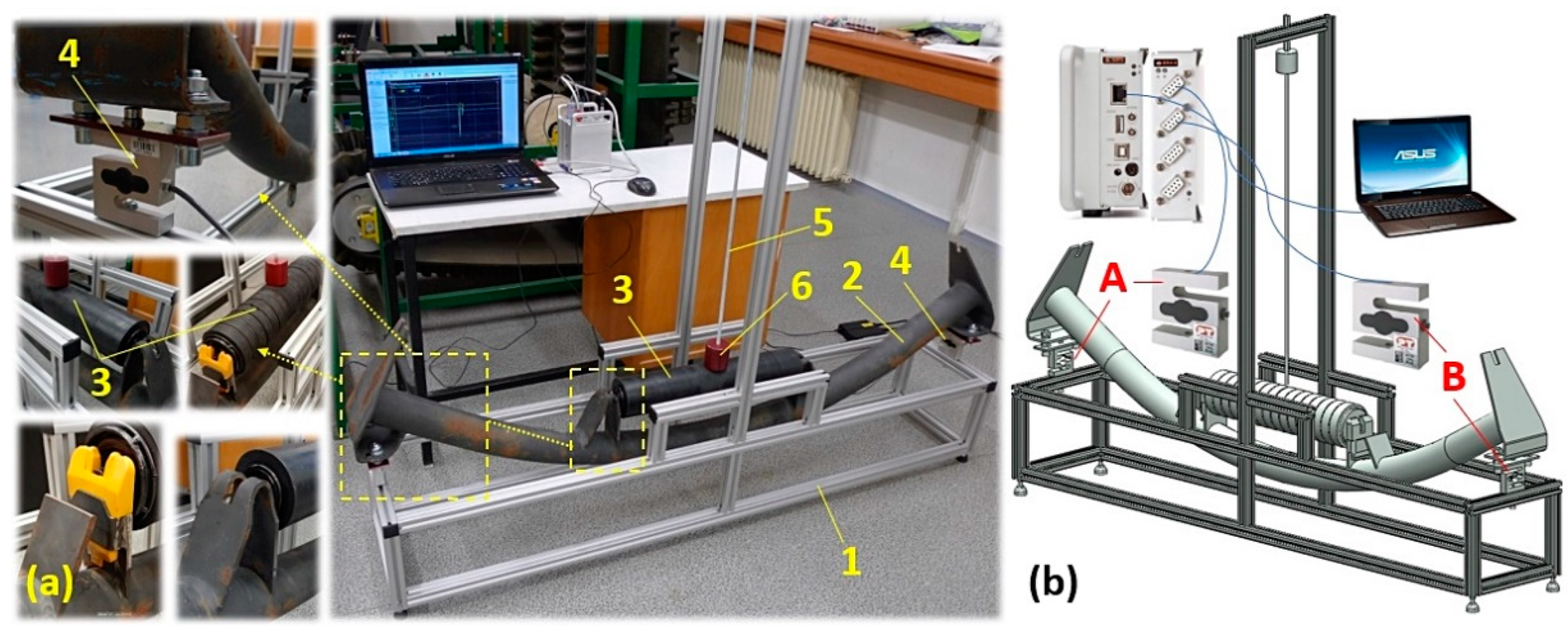





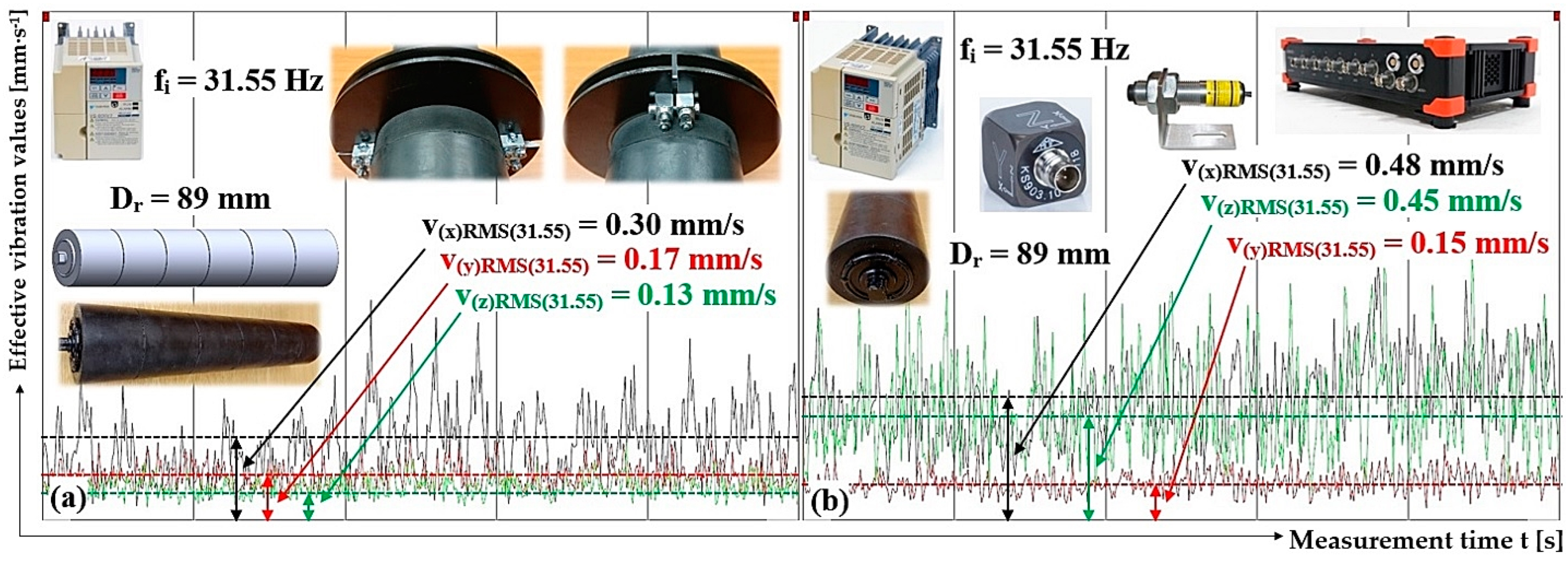
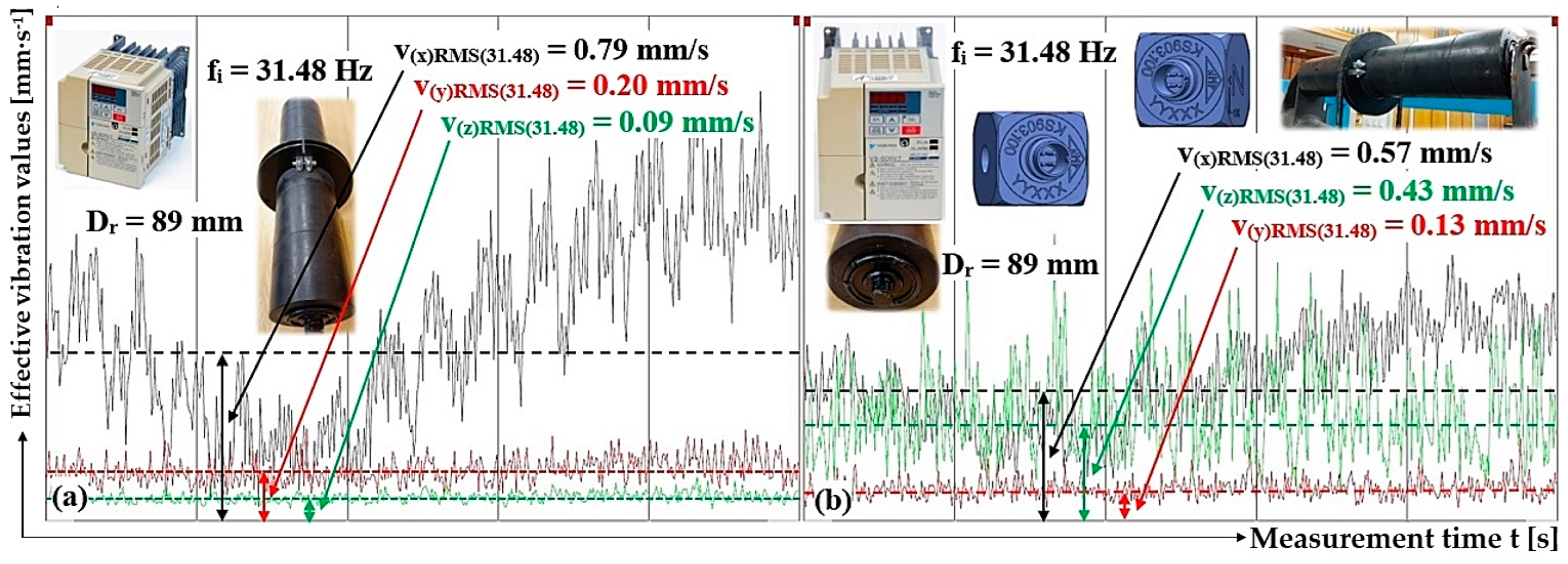

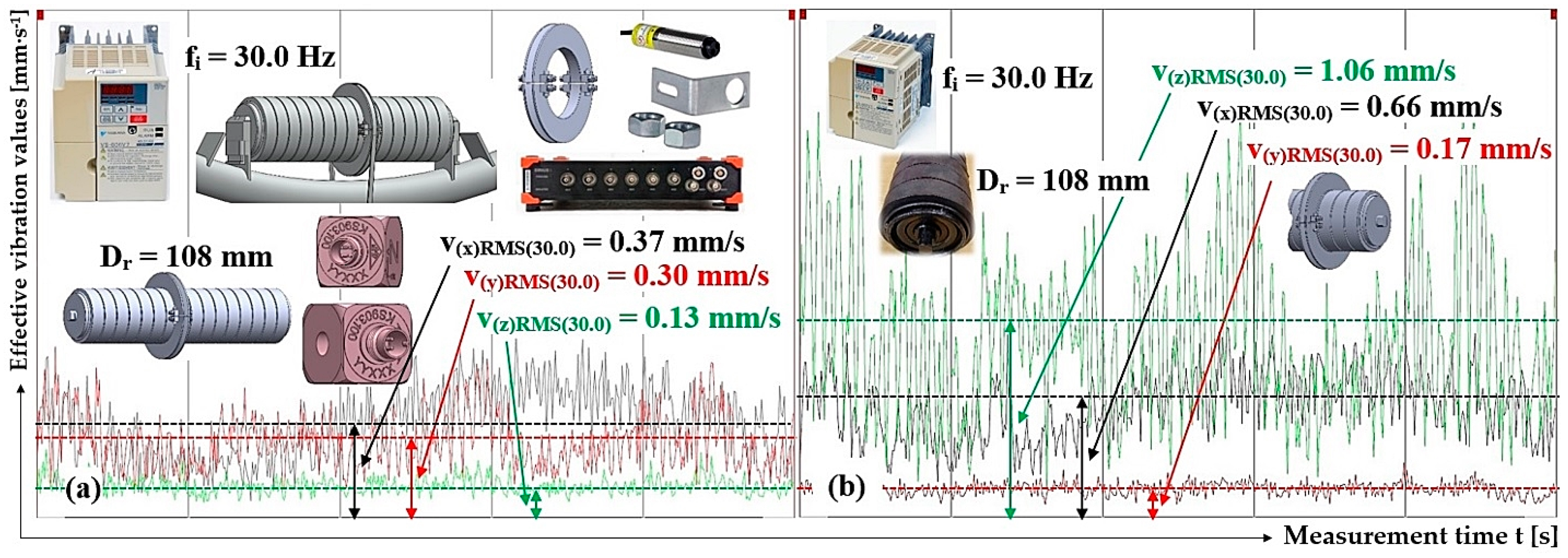
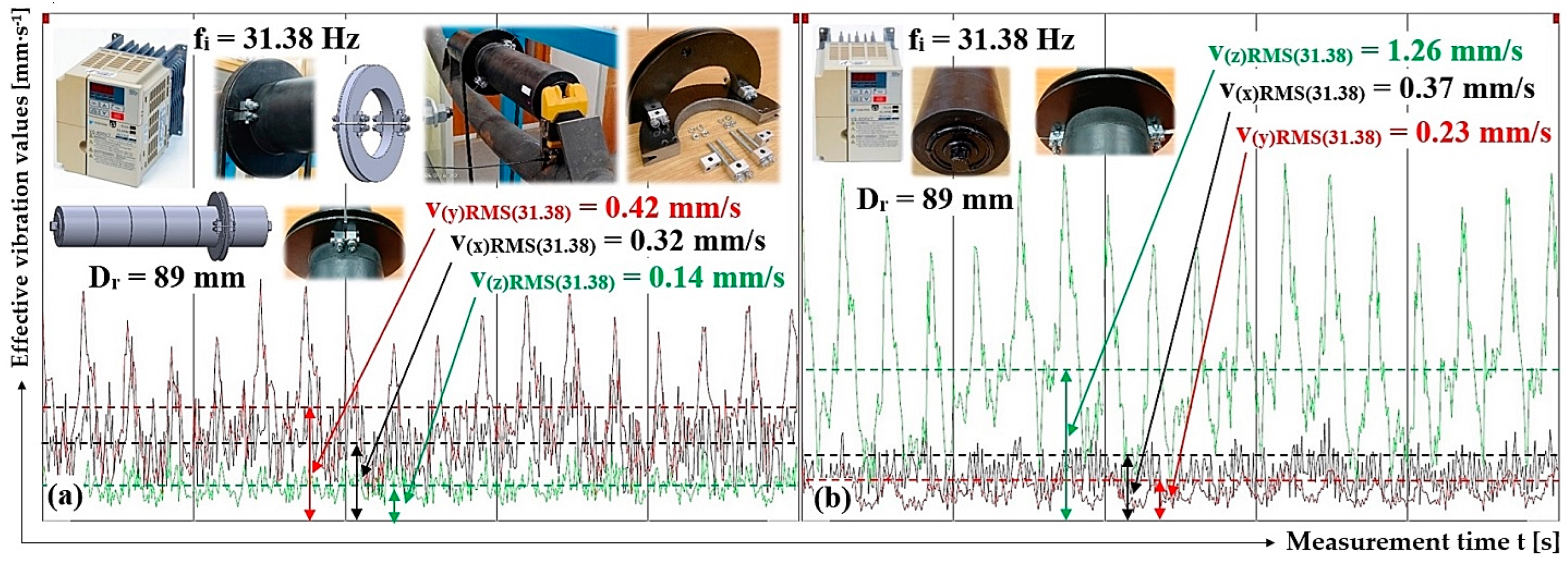
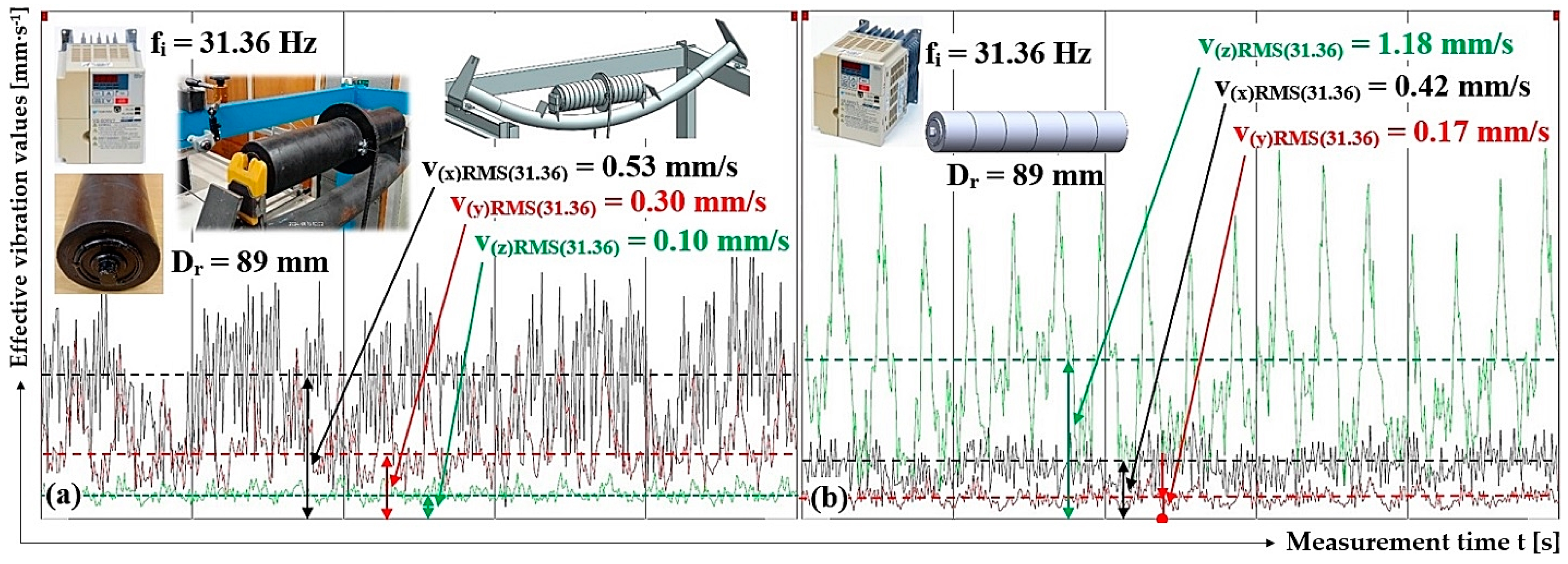

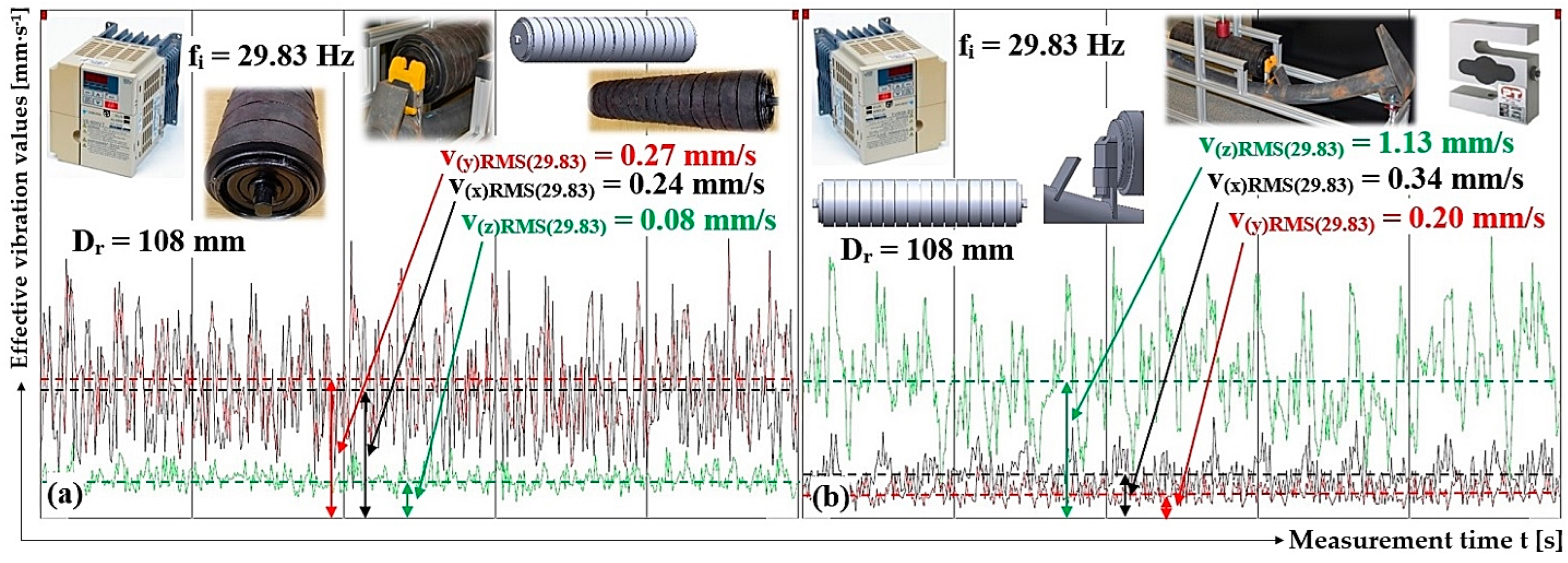

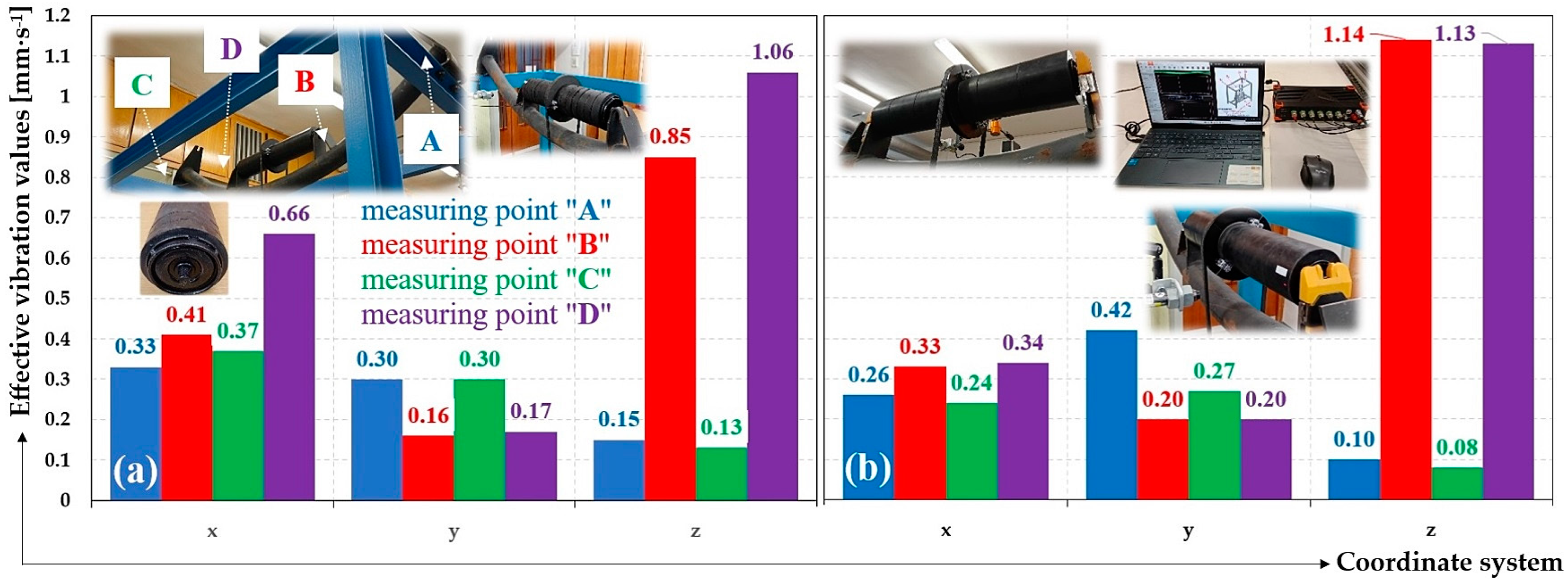
| Dr [mm] | 89 | 108 | ||||
|---|---|---|---|---|---|---|
| vr [m·s−1] | fi [Hz] | nr [s−1] | nr [min−1] | fi [Hz] | nr [s−1] | nr [min−1] |
| 3.15 | 41.28 | 11.27 | 675.96 | 38.55 | 9.28 | 557.04 |
| 2.50 | 32.76 | 8.94 | 536.48 | 30.59 | 7.37 | 442.10 |
| 1.25 | 16.38 | 4.47 | 268.24 | 15.30 | 3.68 | 221.05 |
| Dr [mm] | 89 | ||||||
|---|---|---|---|---|---|---|---|
| F0(Dr)j,i [N] | Measurement point “j” | F(Dr)j,i [N] | Measurement point “j” | F(Dr)j,i − F0(Dr)j,i | |||
| “A” | “B” | “A” | “B” | “A” | “B” | ||
| 119.3 | 122.8 | 202.9 | 208.2 | 83.6 | 85.4 | ||
| 119.4 | 123.0 | 202.7 | 207.6 | 83.3 | 84.6 | ||
| 119.1 | 122.9 | 203.5 | 209.8 | 84.1 | 86.9 | ||
| 119.4 1 | 123.0 1 | 204.8 2 | 210.4 2 | 85.7 | 87.4 | ||
| 119.6 | 123.6 | 201.9 | 206.9 | 82.3 | 83.3 | ||
| Fd(Dr)j [N] | 83.8 | 85.5 | |||||
| κα,j [N] | 1.5 | 2.3 | |||||
| Dr [mm] | 108 | ||||||
|---|---|---|---|---|---|---|---|
| F0(Dr)j,i [N] | Measurement point “j” | F(Dr)j,i [N] | Measurement point “j” | F(Dr)j,i − F0(Dr)j,i | |||
| “A” | “B” | “A” | “B” | “A” | “B” | ||
| 124.0 | 127.9 | 188.4 | 192.5 | 64.4 | 64.6 | ||
| 123.8 | 127.9 | 186.3 | 192.8 | 62.5 | 64.9 | ||
| 123.5 | 127.7 | 174.5 | 178.8 | 51.0 | 51.1 | ||
| 123.8 1 | 127.9 1 | 193.5 2 | 198.9 2 | 69.7 | 71.0 | ||
| 123.5 | 127.9 | 179.6 | 187.5 | 56.1 | 59.6 | ||
| Fd(Dr)j [N] | 60.7 | 62.2 | |||||
| κα,j [N] | 10.0 | 9.6 | |||||
| Dr [mm] | 89 | ||||||
|---|---|---|---|---|---|---|---|
| F0(Dr)j,i [N] | Measurement point “j” | F(Dr)j,i [N] | Measurement point “j” | F(Dr)j,i − F0(Dr)j,i | |||
| “A” | “B” | “A” | “B” | “A” | “B” | ||
| 114.9 | 122.5 | 201.6 | 219.6 | 86.7 | 90.1 | ||
| 114.8 | 129.5 | 200.5 | 218.4 | 85.7 | 88.9 | ||
| 114.8 | 129.6 | 203.2 | 219.9 | 88.4 | 90.3 | ||
| 115.3 1 | 130.3 1 | 201.7 2 | 218.5 2 | 86.4 | 88.2 | ||
| 117.0 | 131.4 | 202.4 | 218.8 | 85.4 | 87.4 | ||
| Fd(Dr)j [N] | 86.5 | 89.0 | |||||
| κα,j [N] | 1.4 | 1.7 | |||||
| Dr [mm] | 108 | ||||||
|---|---|---|---|---|---|---|---|
| F0(Dr)j,i [N] | Measurement point “j” | F(Dr)j,i [N] | Measurement point “j” | F(Dr)j,i − F0(Dr)j,i | |||
| “A” | “B” | “A” | “B” | “A” | “B” | ||
| 119.4 | 134.3 | 187.2 | 203.1 | 67.8 | 68.8 | ||
| 119.8 | 134.7 | 190.9 | 207.2 | 71.1 | 72.5 | ||
| 121.3 | 136.1 | 190.2 | 206.9 | 68.9 | 70.8 | ||
| 120.8 1 | 135.8 1 | 195.6 2 | 209.1 2 | 74.8 | 73.3 | ||
| 120.1 | 135.0 | 199.4 | 214.0 | 79.3 | 79.0 | ||
| Fd(Dr)j [N] | 72.4 | 72.9 | |||||
| κα,j [N] | 6.5 | 4.6 | |||||
| fi | nr | vr | Measurement Point “A” | Measurement Point “B” | ||||
|---|---|---|---|---|---|---|---|---|
| v(x)RMS(fi) | v(y)RMS(fi) | v(z)RMS(fi) | v(x)RMS(fi) | v(y)RMS(fi) | v(z)RMS(fi) | |||
| [Hz] | [min−1] | [m·s−1] | [mm·s−1] | [mm·s−1] | ||||
| 39.84 | 677 | 3.16 | 0.21 | 0.20 | 0.12 | 0.47 | 0.13 | 0.57 |
| 31.55 | 536 | 2.50 | 0.30 1 | 0.17 1 | 0.13 1 | 0.48 2 | 0.15 2 | 0.45 2 |
| 16.28 | 268 | 1.25 | 0.15 | 0.10 | 0.08 | 0.19 | 0.07 | 0.16 |
| fi | nr | vr | Measurement Point “C” | Measurement Point “D” | ||||
|---|---|---|---|---|---|---|---|---|
| v(x)RMS(fi) | v(y)RMS(fi) | v(z)RMS(fi) | v(x)RMS(fi) | v(y)RMS(fi) | v(z)RMS(fi) | |||
| [Hz] | [min−1] | [m·s−1] | [mm·s−1] | [mm·s−1] | ||||
| 39.82 | 677 | 3.15 | 0.44 | 0.21 | 0.10 | 0.54 | 0.11 | 0.62 |
| 31.48 | 535 | 2.49 | 0.79 1 | 0.20 1 | 0.09 1 | 0.57 2 | 0.13 2 | 0.43 2 |
| 15.78 | 268 | 1.25 | 0.15 | 0.09 | 0.07 | 0.17 | 0.08 | 0.16 |
| fi | nr | vr | Measurement Point “A” | Measurement Point “B” | ||||
|---|---|---|---|---|---|---|---|---|
| v(x)RMS(fi) | v(y)RMS(fi) | v(z)RMS(fi) | v(x)RMS(fi) | v(y)RMS(fi) | v(z)RMS(fi) | |||
| [Hz] | [min−1] | [m·s−1] | [mm·s−1] | [mm·s−1] | ||||
| 37.72 | 559 | 3.16 | 0.38 | 0.32 | 0.18 | 0.56 | 0.20 | 0.92 |
| 29.98 | 444 | 2.51 | 0.33 1 | 0.30 1 | 0.15 1 | 0.41 2 | 0.16 2 | 0.85 2 |
| 14.96 | 222 | 1.25 | 0.10 | 0.15 | 0.08 | 0.16 | 0.10 | 0.36 |
| fi | nr | vr | Measurement Point “C” | Measurement Point “D” | ||||
|---|---|---|---|---|---|---|---|---|
| v(x)RMS(fi) | v(y)RMS(fi) | v(z)RMS(fi) | v(x)RMS(fi) | v(y)RMS(fi) | v(z)RMS(fi) | |||
| [Hz] | [min−1] | [m·s−1] | [mm·s−1] | [mm·s−1] | ||||
| 37.73 | 559 | 3.16 | 0.35 | 0.33 | 0.13 | 0.72 | 0.21 | 1.06 |
| 30.00 | 444 | 2.51 | 0.37 1 | 0.30 1 | 0.13 1 | 0.66 2 | 0.17 2 | 1.06 2 |
| 14.97 | 222 | 1.25 | 0.12 | 0.14 | 0.08 | 0.20 | 0.10 | 0.37 |
| fi | nr | vr | Measurement Point “A” | Measurement Point “B” | ||||
|---|---|---|---|---|---|---|---|---|
| v(x)RMS(fi) | v(y)RMS(fi) | v(z)RMS(fi) | v(x)RMS(fi) | v(y)RMS(fi) | v(z)RMS(fi) | |||
| [Hz] | [min−1] | [m·s−1] | [mm·s−1] | [mm·s−1] | ||||
| 39.64 | 674 | 3.14 | 0.34 | 0.61 | 0.13 | 0.45 | 0.31 | 1.91 |
| 31.38 | 533 | 2.49 | 0.32 1 | 0.42 1 | 0.14 1 | 0.37 2 | 0.23 2 | 1.26 2 |
| 15.72 | 267 | 1.24 | 0.14 | 0.19 | 0.07 | 0.17 | 0.12 | 0.53 |
| fi | nr | vr | Measurement Point “C” | Measurement Point “D” | ||||
|---|---|---|---|---|---|---|---|---|
| v(x)RMS(fi) | v(y)RMS(fi) | v(z)RMS(fi) | v(x)RMS(fi) | v(y)RMS(fi) | v(z)RMS(fi) | |||
| [Hz] | [min−1] | [m·s−1] | [mm·s−1] | [mm·s−1] | ||||
| 39.56 | 672 | 3.13 | 0.32 | 0.49 | 0.10 | 0.44 | 0.19 | 1.98 |
| 31.36 | 533 | 2.48 | 0.53 1 | 0.30 1 | 0.10 1 | 0.42 2 | 0.17 2 | 1.18 2 |
| 15.70 | 267 | 1.24 | 0.19 | 0.14 | 0.06 | 0.20 | 0.10 | 0.43 |
| fi | nr | vr | Measurement Point “A” | Measurement Point “B” | ||||
|---|---|---|---|---|---|---|---|---|
| v(x)RMS(fi) | v(y)RMS(fi) | v(z)RMS(fi) | v(x)RMS(fi) | v(y)RMS(fi) | v(z)RMS(fi) | |||
| [Hz] | [min−1] | [m·s−1] | [mm·s−1] | [mm·s−1] | ||||
| 37.62 | 557 | 3.15 | 0.73 | 0.57 | 0.22 | 0.71 | 0.48 | 1.20 |
| 29.84 | 442 | 2.50 | 0.26 1 | 0.42 1 | 0.10 1 | 0.33 2 | 0.20 2 | 1.14 2 |
| 14.87 | 220 | 1.25 | 0.11 | 0.18 | 0.07 | 0.20 | 0.10 | 0.46 |
| fi | nr | vr | Measurement Point “C” | Measurement Point “D” | ||||
|---|---|---|---|---|---|---|---|---|
| v(x)RMS(fi) | v(y)RMS(fi) | v(z)RMS(fi) | v(x)RMS(fi) | v(y)RMS(fi) | v(z)RMS(fi) | |||
| [Hz] | [min−1] | [m·s−1] | [mm·s−1] | [mm·s−1] | ||||
| 37.62 | 557 | 3.15 | 0.77 | 0.43 | 0.10 | 0.66 | 0.65 | 1.22 |
| 29.83 | 442 | 2.50 | 0.24 1 | 0.27 1 | 0.08 1 | 0.34 2 | 0.20 2 | 1.13 2 |
| 14.86 | 220 | 1.24 | 0.11 | 0.12 | 0.05 | 0.21 | 0.13 | 0.46 |
Disclaimer/Publisher’s Note: The statements, opinions and data contained in all publications are solely those of the individual author(s) and contributor(s) and not of MDPI and/or the editor(s). MDPI and/or the editor(s) disclaim responsibility for any injury to people or property resulting from any ideas, methods, instructions or products referred to in the content. |
© 2024 by the authors. Licensee MDPI, Basel, Switzerland. This article is an open access article distributed under the terms and conditions of the Creative Commons Attribution (CC BY) license (https://creativecommons.org/licenses/by/4.0/).
Share and Cite
Hrabovský, L.; Kurač, D.; Pravda, Š.; Nováková, E.; Machálek, T. Measuring Device Detecting Impact Forces on Impact Rollers. Processes 2024, 12, 850. https://doi.org/10.3390/pr12050850
Hrabovský L, Kurač D, Pravda Š, Nováková E, Machálek T. Measuring Device Detecting Impact Forces on Impact Rollers. Processes. 2024; 12(5):850. https://doi.org/10.3390/pr12050850
Chicago/Turabian StyleHrabovský, Leopold, Daniel Kurač, Štěpán Pravda, Eliška Nováková, and Tomáš Machálek. 2024. "Measuring Device Detecting Impact Forces on Impact Rollers" Processes 12, no. 5: 850. https://doi.org/10.3390/pr12050850
APA StyleHrabovský, L., Kurač, D., Pravda, Š., Nováková, E., & Machálek, T. (2024). Measuring Device Detecting Impact Forces on Impact Rollers. Processes, 12(5), 850. https://doi.org/10.3390/pr12050850






